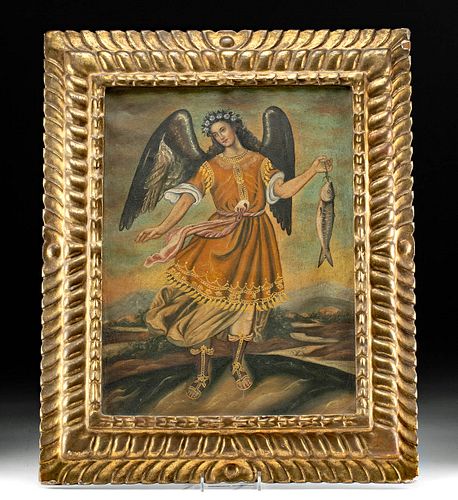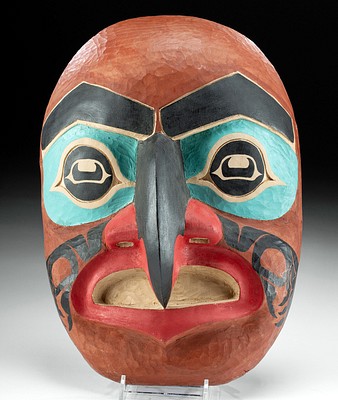Early 20th C. Peru Painting, 19th C. Frame, San Raphael
Lot 1
About Seller
Artemis Fine Arts
686 S Taylor Ave, Ste 106
Louisville, CO 80027
United States
Selling antiquities, ancient and ethnographic art online since 1993, Artemis Gallery specializes in Classical Antiquities (Egyptian, Greek, Roman, Near Eastern), Asian, Pre-Columbian, African / Tribal / Oceanographic art. Our extensive inventory includes pottery, stone, metal, wood, glass and textil...Read more
Estimate:
$800 - $1,200
Absentee vs Live bid
Two ways to bid:
- Leave a max absentee bid and the platform will bid on your behalf up to your maximum bid during the live auction.
- Bid live during the auction and your bids will be submitted real-time to the auctioneer.
Bid Increments
| Price | Bid Increment |
|---|---|
| $0 | $25 |
| $300 | $50 |
| $1,000 | $100 |
| $2,000 | $250 |
| $5,000 | $500 |
| $10,000 | $1,000 |
| $20,000 | $2,500 |
| $50,000 | $5,000 |
| $100,000 | $10,000 |
| $200,000 | $20,000 |
About Auction
By Artemis Fine Arts
Sep 2, 2021
Set Reminder
2021-09-02 12:00:00
2021-09-02 12:00:00
America/New_York
Bidsquare
Bidsquare : Summer Art Auction | Fine | Folk | Fun
https://www.bidsquare.com/auctions/artemis-gallery/summer-art-auction-fine-folk-fun-7395
Featuring visual treats from around the world, and back in time to present day - fine art, folk art, and fun artsy objects. Paintings. Sculptures. Textiles. More. Convenient in-house shipping. Artemis Fine Arts info@artemisgallery.com
Featuring visual treats from around the world, and back in time to present day - fine art, folk art, and fun artsy objects. Paintings. Sculptures. Textiles. More. Convenient in-house shipping. Artemis Fine Arts info@artemisgallery.com
- Lot Description
Central to South American, probably Peru, frame is 19th century, painting is early 20th century. A beautiful oil on canvas painting depicting the archangel Raphael dressed in his traditional flowing vestments with magnificent wings framing his form, holding a single fish in his left hand. The fish is a common identifier for Raphael, and is a reference to Raphael's appearance in the Book of Tobit in the Catholic Bible. In that story, Raphael uses the gallbladder of a fish to heal Tobit's blindness. Hence, he is the patron saint of eyesight and travel. The figure is delineated in a rich jewel tone palette with beautiful modeling as well as a penchant for elegant line. In addition, the artist employed both linear and aerial perspective to provide a sense of depth - placing the archangel in the foreground, very close to the picture plane, and creating a picturesque landscape with rolling hills, mountains, and celestial skies in the distance. The frame is meticulously carved in relief, its composition divided into three borders that progressively recede in space - the first carved with ribbon-like motifs, the second with feather or wing-like motifs, the culminating border presenting repeated leaves with floral motifs adorning the centers of each side. Size of painting: 15.75" L x 11.75" W (40 cm x 29.8 cm) Size of frame: 21.3" L x 17.25" W (54.1 cm x 43.8 cm)
Peru has a long tradition of European-influenced religious painting. The Cuzco School (Escuela Cuzquena) was a Roman Catholic artistic tradition which originated following the 1534 Spanish Conquest of the Inca Empire and continued during the Colonial Period in the sixteenth, seventeenth, and eighteenth centuries. Though based in Cusco, Peru (the former capital of the Inca Empire), the Cuzco School extended to other cities of the Andes, present day Bolivia, and Ecuador. Today it is regarded as the first artistic center that taught European visual art techniques in the Americas. The primary intention of Cuzco School paintings was to be didactic. Hoping to convert the Incas to Catholicism, the Spanish sent religious artists to Cusco who created a school for the Quechua peoples and mestizos. Interestingly, Cusquena art was created by the indigenous as well as Spanish creoles. In addition to religious subjects, the Cuzco School expressed their cultural pride with paintings of Inca monarchs. Despite the fact that Cuzco School painters had studied prints of Flemish, Byzantine, and Italian Renaissance art, these artists' style and techniques were generally freer than that of their European models.
Provenance: ex House of Ancestors, Santa Fe, New Mexico, USA
All items legal to buy/sell under U.S. Statute covering cultural patrimony Code 2600, CHAPTER 14, and are guaranteed to be as described or your money back.
A Certificate of Authenticity will accompany all winning bids.
PLEASE NOTE: Due to recent increases of shipments being seized by Australian & German customs (even for items with pre-UNESCO provenance), we will no longer ship most antiquities and ancient Chinese art to Australia & Germany. For categories of items that are acceptable to ship to Australia or Germany, please contact us directly or work with your local customs brokerage firm.
Display stands not described as included/custom in the item description are for photography purposes only and will not be included with the item upon shipping.
#167025Some chips/abrasions to finish on the frame. Slight stains and age wear to the painting, but imagery and coloring are still vivid. Frame has a hook as well as a wire for suspension on the verso.Condition
- Shipping Info
-
All shipping is handled in-house for your convenience. Your invoice from Artemis Gallery will include shipping calculation instructions. If in doubt, please inquire BEFORE bidding for estimated shipping costs for individual items.
-
- Buyer's Premium



 EUR
EUR CAD
CAD AUD
AUD GBP
GBP MXN
MXN HKD
HKD CNY
CNY MYR
MYR SEK
SEK SGD
SGD CHF
CHF THB
THB













